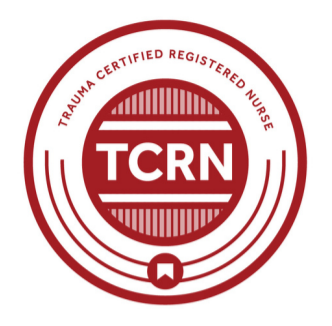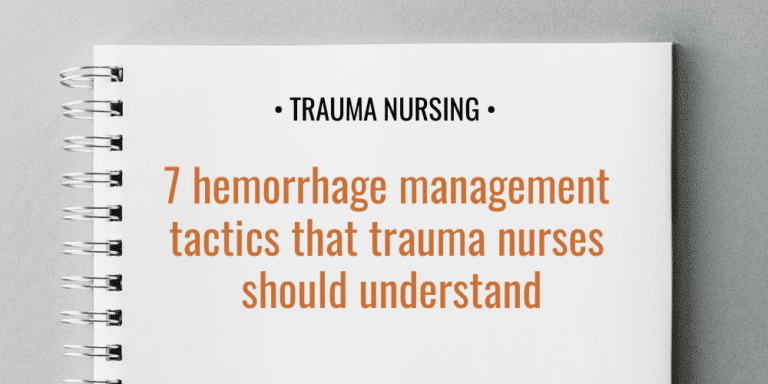Uncontrolled bleeding is one of the main contributors to mortality following traumatic injury. While controlling the source of bleeding is crucial, other strategies are often important for ensuring a positive patient outcome.
Trauma and emergency nurses should understand these strategies and how they are used to manage traumatic bleeding.
1. Identifying hidden bleeds with point-of-care ultrasound
Point-of-care ultrasound technology can be used to identify free fluid in the body that may indicate internal bleeding.
- The Focused Assessment with Sonography in Trauma (FAST) exam is used to identify hemopericardium (bleeding in the space around the heart) and hemoperitoneum (bleeding in the abdomen).
- The Extended-FAST (E-FAST) exam includes additional pleural views to assess for the presence of pneumothorax (collapsed lung) and hemothorax (bleeding in the pleural cavity).
FAST and/or E-FAST should be performed on all patients with multisystem traumatic injuries or trauma to the torso. Both exams are quick, noninvasive and easy to perform and can detect free fluid volumes as low as 100 mL.
However, note that these exams do not identify retroperitoneal bleeding. In addition, a negative FAST or E-FAST does not rule out intra-abdominal bleeding.
2. Controlling pelvic bleeding with a pelvic binder
A pelvic fracture can lead to significant hemorrhage. For patients with pelvic fracture, a pelvic binder may provide preliminary stabilization by closing up the pelvic space.
If a radiograph or a physical exam reveals pelvic instability, an open-book pelvic fracture or vertical displacement of the posterior pelvis, the trauma team should apply a pelvic binder immediately.
Commercial binders are available, but providers can also use a simple bedsheet to bind the pelvis tightly.
- Do: The pelvic binder should be secured at the level of the greater trochanters and the symphysis pubis.
- Don’t: The pelvic binder should not be secured over the iliac crests. Placement over the iliac crests may worsen bleeding and pain.
Be aware that a pelvic binder is a temporary measure intended to control bleeding until embolization or surgical fixation can be performed.
3. Controlling non-compressible bleeding with REBOA
Trauma to the torso that results in internal bleeding cannot be managed by direct pressure or tourniquet. For these trauma patients, resuscitative endovascular balloon occlusion of the aorta (REBOA) is an intravascular procedure that can limit internal bleeding while the patient is prepared for surgery.
During the REBOA procedure, a catheter-guided balloon is inserted into the aorta, positioned above an area of hemorrhage, and inflated to occlude blood flow. This reduces bleeding beyond the occluded site, allowing time for resuscitation and hemorrhage control.
In general, REBOA should be considered for all patients who present with symptoms of shock and have an injury mechanism that suggests bleeding in the torso. Definitive surgical care should be immediately available for patients receiving REBOA.
4. Giving massive transfusion to replace lost blood volume
Massive transfusion protocol (MTP) involves rapidly infusing a large volume of blood products to patients who have experienced significant blood loss.
Several studies suggest that patients with severe trauma and coagulopathy who require MTP are more likely to be successfully resuscitated when the ratio of transfused units of plasma to platelets to red blood cells approaches 1:1:1.
The inclusion criteria for MTP will vary by hospital, and these criteria will likely evolve as new research emerges. However, the current recommendations for initiating MTP include:
- Adults with systolic blood pressure (SBP) <70 mmHg
- Adults with a pulse >110 beats/minute and SBP <90 mmHg
- Penetrating injuries or major fractures
- Identification of fluid in body cavities likely to be blood
5. Proactively responding to the components of the lethal diamond
In addition to controlling hemorrhage and replacing lost blood volume, the trauma team must also monitor the patient for the components of the lethal diamond and address them proactively.
The lethal trauma diamond is the “vicious cycle” of four physiologic derangements that can prolong blood loss, lead to hemorrhagic shock and increase the risk of death. The four points of the diamond are coagulopathy, acidosis and hypothermia (the traditional “lethal trauma triad”) and hypocalcemia. (To learn more, read 4 facts about the lethal trauma diamond that nurses should know.)
- Interventions to mitigate the effects of coagulopathy include avoiding excessive fluid administration (which can dilute already diminished clotting factors) and early administration of blood products using a 1:1:1 ratio.
- Acidosis can be mitigated by avoiding excessive fluid administration, assuring appropriate oxygenation and obtaining early hemorrhage control.
- Interventions to mitigate hypocalcemia include early evaluation of baseline serum ionized calcium levels for patients who will be receiving blood products and ongoing evaluation of calcium levels during MTP or multiple blood product administration.
- Several interventions are available for mitigating hypothermia, including using a warming infusion device, increasing the temperature in the resuscitation room, and simply using warm blankets on the patient.
6. Leveraging lab studies to monitor coagulopathy
Monitoring a patient’s clotting ability through laboratory work allows the trauma team to identify trauma-induced coagulopathy and tailor treatments to meet the patient’s specific needs.
The following lab findings indicate possible coagulopathy:
- Prothrombin time (PT) >18 seconds
- International normalized ratio (INR) >1.5 seconds
- Activated partial thromboplastin Time (PTT) > 60 seconds
Any of these findings may indicate the need for plasma or platelets to facilitate hemostasis. The trauma team may also consider the need to reverse anticoagulation medications. For example, warfarin can be reversed using vitamin K and prothrombin complex concentrate (PCC).
Viscoelastic hemostasis assays — including thromboelastography (TEG) and rotational thromboelastography (RoTEM) — are gaining popularity due to their ability to provide point-of-care testing and accurately assess the patient’s current coagulation status.
These technologies can help trauma teams implement targeted interventions for patients with coagulopathy. For instance, if RoTEM indicates hyperfibrinolysis (rapid breakdown of blood clots), the trauma team may decide to administer a tranexamic acid (TXA) infusion to increase clot stability.
7. Incorporating pharmacological interventions into resuscitation for severe hemorrhage
Pharmacological adjuncts are part of a comprehensive approach to severe bleeding. Important options include:
- The administration of calcium (chloride or gluconate) to prevent the complications associated with hypocalcemia.
- The use of TXA in adult trauma patients to stabilize clots and control bleeding.
- Minimized use of crystalloids. The current recommendation is to only infuse intravenous fluids to hypotensive trauma patients to maintain a mean arterial pressure (MAP) above 65 mmHg and only until blood products become available.



